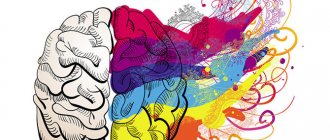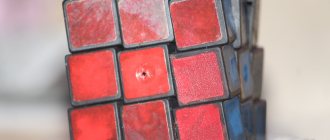Although many people think that only composers, writers, artists and some other representatives of certain creative professions need to develop creative thinking, this statement is not true! Why? The thing is that with the help of well-developed creative thinking, you can find optimal ways out of the most difficult and unusual life situations, successfully solve everyday everyday issues, see something new in things that have long been familiar, quickly and correctly respond to any problem, etc. .d.
Creative thinking needs to be developed not only by those people who are directly related to creative areas of life, but also by ordinary managers, clerks, accountants, schoolchildren and students, parents, etc. Why and why? Because a manager who knows how to think non-trivially and creatively will be able to sell more goods, an accountant will be able to find a way to save a significant amount of money for his company, a student will be able to find a well-paid and promising job, a parent will be able to teach his child to go beyond the generally accepted framework and create something new. .
What is creative thinking? Why does it need to be developed? What effective and efficient ways to develop creative potential are there? We bring to your attention the top 10 methods and exercises for the development of creative thinking, thanks to which you will learn to think creatively and be able to expand the boundaries of your worldview!
Definition
Human creative thinking is the process of getting acquainted with information, processing it and creating new ideas.
In pedagogy, the importance of this type of thinking is noted due to the fact that the individual independently strives to obtain new knowledge and quickly apply it in practice. This applies not only to music and drawing lessons, but also to history, social studies, etc.
In addition, speaking about children with a predisposition to this type of thinking, the importance of having this criterion for learning, as well as socialization, is noted.
Turn even the most boring things into interesting things
Stimulating cognitive activity is perhaps the most important task of any teacher, but it is no less important to maintain this level. Routine presentation of material can negate all efforts made earlier and completely discourage a child from learning new things.
That is why it is so important to make the learning process as interesting as possible. Imagination and creative thinking are the best helpers in this.
Children should always have the opportunity to express their own point of view, to demonstrate the angle from which they see a particular situation. This can happen not only directly during the lesson, but also when doing tests or independent work. In literature, for example, essays on non-standard topics are great for this. Most often, teachers invite their students to write a work in which the main character is a minor character of the work being studied.
In mathematics, this can be an unusual way of presenting material. Fractions, for example, can be studied using tangerine slices as an example. The formation of creative thinking in this case occurs through the use of a clear example and increased interest in what is being studied.
What is creative thinking
Today you can hear everywhere about how important creative thinking, creativity, and a creative approach to business are. These qualities are indicated in vacancies for prestigious positions; they are offered to be developed at numerous seminars, trainings, and coaching. Teachers talk about them to parents, managers to subordinates. But unfortunately, these concepts remain vague and incomprehensible for many. Let's look into them.
Creativity as an activity
Let's start with the fact that the ability to be creative is unique to humans, and all people have a need for creative activity from birth. Yes, yes, children are born with this need. Potential, of course, is different for everyone, but it is there, and it can be developed at any age.
Creativity in psychology is defined as spiritual and practical activity aimed at creating something new. This new thing can be born in any field, not just in the field of art or science. In construction and pedagogy, in cooking and management - creativity is possible everywhere.
Any human activity can be of two types:
- Reproductive is an activity that reproduces according to a given pattern. For example, when a child writes a dictation, a housewife bakes a pie according to a recipe, a builder builds a house according to a drawing, or a needlewoman knits a scarf according to a pattern. This is a very important and necessary activity, a necessary part of training, without it professionalism is impossible. And in everyday life there is no point in “reinventing the wheel” every time.
- Creative activity is what is called creativity; it is distinguished by the novelty of the result or methods. It is built on the basis of reproductive, but having mastered professional techniques, a person begins to feel the need to do something of his own, original, new, since he is bored and uninterested in following only someone else’s model.
But it is not without reason that creativity is called a spiritual-practical activity. The need to create something new gives rise to a person’s idea, plan, project. The emergence of a new, original idea and understanding of ways to implement it is creative thinking.
"Discovery" of creative thinking
For a long time, until the middle of the 20th century, abstract logical thinking was unconditionally considered the highest form of mental activity. Its strict laws, derived by ancient philosophers, were studied in school, and people who were not inclined to logical thinking were treated leniently. Even intelligence tests (IQ), developed at the beginning of the last century, were focused on testing mastery of logic and the development of abstract logical thinking.
But it turned out that among individuals with an intelligence level above 135% there are almost no outstanding scientists, world-famous cultural figures, artists, writers and those who have achieved great success in business.
People who receive high scores on these tests are unable to solve non-standard problems; they cannot come up with anything new and original. And the dynamically developing industry, the emergence of new industries and services, and increasing competition required non-standard solutions.
The tests were refined, improved, and entire scientific teams were involved in them, for example, at Stanford University in the USA, but this still did not solve the problem. People with high IQs, responsible, erudite, highly intelligent professionals turned out to be unable to go beyond strict instructions and come up with something of their own. But success was achieved by the average people, those whose level of intelligence was only slightly above the acceptable limit of the norm.
It was then that it became clear that logical thinking is not a panacea and there is more productive and effective thinking - creative thinking. It allows a person:
- find a way out of seemingly hopeless situations;
- solve non-standard problems that are not amenable to algorithmic methods;
- discover new scientific laws;
- create new things;
- see any problem from a completely non-standard angle.
It was not for nothing that A. Einstein said: “I would never have made my discoveries in the process of rational thinking.”
Thinking in different directions
What is significant is that one of the first to talk about a special type of thinking was intelligence researcher and developer of IQ tests J. Guilford. Many years of research led him to the conclusion that the most amazing scientific discoveries and original inventions are made not on the basis of logic, but in spite of it. And classical logical thinking, both deductive and inductive, is not able to solve non-standard problems in which there is not one single correct answer.
- Guilford called a special type of thinking, which contradicts the logical, but is the basis of creativity, “divergent” - divergent, going in different directions, multidirectional.
- This thinking differs from standard logical thinking, which is linear, that is, directed in one direction, focused on achieving the only correct or optimal solution.
Throughout the second half of the 20th century, creative thinking was actively studied by psychologists, as they realized that human civilization exists, and the state prospers thanks to creative people endowed with creative abilities. Those who have long been condescendingly called eccentrics.
Age characteristics
Preschoolers
Children with creative thinking can be distinguished from the general crowd even in kindergarten. They don’t like to perform synchronous, identical movements with everyone else (for example, during morning exercises) and come up with their own.
In the game, they take the initiative because they are simply bursting with ideas on how best to distribute roles and what to place where. However, other guys often don’t understand them, because they think in original images.
Instead of eating an apple for an afternoon snack, they nibble it in such a way as to make some kind of figure.
However, it is not always possible to recognize the creative potential in a little person. They are often secretive, because they are too focused on their inner world and images. Drawing with a plot helps to identify the levels of creative thinking of preschoolers.
Typically, tests to determine the level of creative thinking are carried out in preschool children (5-6 years old), so that the data obtained can be used in the future - when studying at school.
Primary School
From grades 1 to 4, the creative thinking of younger schoolchildren is characterized by the following features:
- quickly solving educational problems (using non-standard methods);
- identifying potential in a specific area (music, literature, drawing, modeling);
- unusual judgments, your own view of the familiar world;
- refusal to perform template tasks according to the sample;
- inattention in class.
The main task of teachers and parents at this stage is to recognize the child’s creative potential and direct all efforts to its development. If the moment is missed in elementary school, these abilities may remain unrealized in the future. As psychologists say, this is where humanity loses the most great artists, musicians and poets.
In elementary school, it is also important to separate the “wheat from the chaff.” At this age, many children play out their fantasy and substitution of concepts occurs. Inspired by the tales of their talented child, parents begin to see in him a great writer who in the future will become an unsurpassed science fiction writer. In fact, these are fictions, most often based on computer games and films. There is no creativity or anything unique there. In psychology, imagination (closely related to creative thinking) and fantasy are completely different concepts.
Middle and senior management
In the middle and senior levels, creativity becomes much clearer. Teenagers are already capable of self-determination without the guidance of adults. Those whose creativity is off the scale occupy positions of leaders of various school and youth associations. The generation of unusual ideas, non-standard ways of solving problems and pressing tasks make them the center of everyone's attention. Others begin to express themselves in some narrow specialization - they become real stars of the local theater group or art studio.
At this age stage there are dangers. Closer to the age of 13, on the threshold of the teenage crisis, creative thinking can play a disservice. In an attempt to prove to everyone their adulthood and independence and due to youthful maximalism, such children begin to too clearly and ardently demonstrate their vision of the world - different from others. All this is accompanied by aggression and daring behavior. The support of parents who can direct all this in the right direction is of great importance here.
1.Morning freewriting
In the morning, are you used to thinking about what needs to be done, but when you come to work, you immediately jump into the abyss of tasks? This is not entirely correct: focusing on the to-do list interferes with the flight of thought.
One way to channel your energy into creativity is through morning freewriting. Take 10 minutes and just write. Unlike a blog or social media, these posts are only available to you, so they don't necessarily have to make any sense. What to write about? You can come up with different topics every day, or you can make a list of questions and choose from it according to your mood. For example:
- If I had more time, I would...
- This week I am grateful...
- I feel uncomfortable when...
- I'm proud of myself because...
- I work better when...
Stereotypes
A talented person is talented in everything. What talent do you have? It cannot be that there is no talent: even a song performed at a corporate party may well turn out to be a sign of real talent. It's all about the stereotypes that are imposed on us by life itself or by the people who surround us since childhood. They are the ones who tell us what is “good” and what is “bad”. As a result, we, like staunch tin soldiers, carry out tasks strictly according to instructions.
Now remember how in childhood you easily got out of any situation. If you can't remember yourself, take a close look at how your own child does it.
The first thing that distinguishes a child from an adult is the ability to think freely figuratively. For a child, every word is a whole picture, every event is a fairy tale. The kid himself can easily transform into any fairy-tale hero and for this he does not have to wait for a costume party. External resemblance to a famous character doesn’t bother him much; he has a creative (different from the generally accepted) approach to everything.
Over the years we are losing this road. We learn rules that we rarely want to break. All because it’s easier, more familiar. Such actions do not cause indignation (envy) of colleagues, do not infuriate (misunderstanding) parents/husband/wife/ and so on.
Most people agree to play according to standard rules. And then the person becomes bored with himself, with his family, with his friends. Meanwhile, her “crazy” classmate Yulka has already headed a department in a large state corporation, her husband is a famous and fashionable photographer (he, by the way, is also “out of this world”). They are happy, and soon they will have their first and, of course, talented child.
So you have something to strive for.
Creativity is just the ability, under normal conditions with all the known components, to put together something that will make, if not turn the world upside down, then at least look at things differently.
Therefore, creative people are especially valued in advertising agencies. They are the ones who force us to buy something that just five minutes ago we didn’t want at all. They are the ones who make us swallow saliva at the mere appearance of “low-calorie” yogurt on the screen. They are the ones who know how to direct our standard thoughts along any path they need.
Stupidity training, or “Oxymoron!”
Place 5 of your favorite animals in the top horizontal boxes and 5 things you use regularly in the vertical boxes. By the way, I have already inserted one on each side.
After this, connect any animal from the horizontal axis with any thing from the vertical axis. Draw the connection option in the intersection cell. The goal is to fill all the empty cells with weirdly stupid new animals.
For example, my item and animal make a comb in the shape of a giraffe's neck or a giraffe centipede.
Creative thinking tests
Of course, once you've realized the benefits of being a creative person, you'll want to know how creative you are. Therefore, below I give you a list of tests that will help diagnose your level of creativity.
- "Torrens test". This is one of the best tests that measure creative thinking. You need to answer the questions without thinking too much about the answers, then you will get truthful results. This is a verbal test, but this technique also has a figurative part, where you should complete the lines at your discretion. This technique is carried out by a specialist.
- “Creativity Test.” By answering 20 questions, you will understand whether you can think creatively and creatively. The test is not scientific, but it can help you understand yourself.
- “Diagnostics of creativity E. Tunik.” You should answer 50 questions to help you understand yourself. After taking the test, your results will be divided into 4 subcategories: risk taking, imagination, curiosity, complexity.
- “Test of Divergent (Creative) Thinking” by Williams. This is a very revealing test by which you can determine the level of creativity of both a child and an adult. According to the instructions, you need to complete 12 images, and the results are assessed according to several criteria. It is better to take this test with a specialist.
Torrens test
One of the most popular diagnostic tools for determining the level of creative thinking is the Torrance test. It is strongly not recommended to do it yourself. This is a specific psychodiagnostic tool that requires a professional approach, especially when interpreting the results. Therefore, it is better to seek help from a specialized specialist. The development presented below is for informational purposes only.
Author: Alice Paul Torrance (1915-2003) - American psychologist.
Full name: “P. Torrance Test of Creative Thinking.”
Diagnosed age: preschool, 6-7 years. There are more complicated versions of the test, which can be carried out between 8 and 20 years.
The main task: to determine the level of creativity.
Test conditions:
- You cannot change a single word in the test, add or remove any pictures.
- Strictly adhere to the time limit allotted for completing tasks - no more than 45 minutes, including explanations and reading instructions.
- Before conducting the test, you need to create a calm, favorable atmosphere.
- Among preschoolers, the test is carried out individually.
- Adults should explain in detail to children all incomprehensible points.
Pictures for the test:
Verbal thinking
Fine creative thinking
Verbal-sound creative thinking
Interpretation of results
Each task is assessed according to the following criteria:
The test results are processed exclusively by a professional psychologist who has undergone special training. On their basis, a conclusion is drawn about the general level of development of creative thinking in a child, as well as the degree of formation of its verbal, visual and verbal-sound subtypes.
9.Notebook with scribbles (doodle)
Are you a visual thinker? Keep a small notebook handy where you can scribble and draw at any time, for example, during a telephone conversation. According to a study published in the scientific journal Applied Cognitive Psychology, such drawing can help a person concentrate and improve memory, as it evenly distributes brain activity between “thinking a lot” and “thinking little.”
Just remember the small drawings by A.S. Pushkin in the margins of manuscripts!
How to develop creative thinking and creativity
Various neurophysiological studies have confirmed that creative thinking involves different areas of the brain that were not previously involved. Give your brain freedom and see how it will work towards creativity. You can develop creative thinking in different ways, some of which we will consider in more detail.
In adults
Stop thinking “like everyone else”, try to come up with different ways out of this or that situation. Cast aside your doubts. Fear of failure deprives you of the opportunity to create.
Brilliant ideas are born only from desperate people.
If all of the above applies to you, all that remains is to improve your abilities and skills. Here are some simple exercises.
- Take a book. Write out a few words from it from the pages and lines you have previously determined. It should turn out to be some kind of gobbledygook. Now combine these words into text. Make up a story.
- Figure out how to expand the possibilities of using the most common item. For example, a plastic bag. This is not only garbage packaging, but also a pool cap, a wallet cover, and a raincoat. By completing this task, you will develop your imagination and help environmentalists.
- Draw lines of different lengths and inclinations, dots, dashes on a piece of paper. Now try to create an image from them. Perhaps it will not be an object, but an event or natural phenomenon.
- Use everything around you to create images. What does that cloud look like, and this puddle under your feet, and this snowdrift under the window?
- Read backwards. Start with words, then move on to whole sentences and pages from books. Imagine what comes out of the text.
In children
Unfortunately, adults often kill children's creativity in the bud. And uncles and aunts do this very creatively, not knowing what they are doing.
Teachers, coaches, parents and other cultural sectors come up with various tournaments and competitions, thinking that in this way they develop boys and girls. But it turns out it's the other way around. The guys strive to get the main prize using a method that has been proven over the years.
Their goal is a reward, not a new discovery.
Most adults are confident that they know everything better than the child and try to protect him from mistakes. As a result, an insurmountable barrier is placed in front of him. Of course, they also know the way to solve the problem. They open their own path of knowledge for the child, not suspecting that the child can choose his own, and much more successful one. Don't put blinders on his eyes.
Let me stumble, but go through the maze in your own way.
We make plans and try to fit the children into this schedule. In the modern world, we give birth to them according to a schedule previously agreed upon with our spouse. At the same time, we want them to feel free. At least sometimes, instead of gymnastics, take your child to the zoo, and instead of a lesson at a music school, offer roller skating. He still has a lot of time ahead of him, which he will have to distribute “correctly”.
Give him the opportunity to fool around. Yes, allow yourself to do this sometimes.
Methods of activation and development
Here we will talk about methods of activating creativity, and about development a little lower. It's no secret that sometimes tasks come in too quickly, and the time to develop creativity is very limited. How to quickly activate creativity?
Psychological method
Look at the objects around you with the thought of solving a specific problem. The right solution will appear in your thinking. This is exactly how V.I. Surikov “found” the image for the noblewoman Morozova in the silhouette of a crow in the snow. This method is applicable even for preschool children. See how their imagination will seethe and spill out!
Instrumental method
Ask yourself difficult problems, such as how to bake a cake if you are running out of flour and there are no eggs. By training every day, you will be able to quickly find different ways out of difficult situations. Working using the “brainstorming” method. This stimulates brain function and improves memory.










